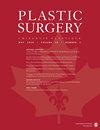门诊整形手术中阿片类药物处方、消费和心理测量相关性的前瞻性分析
IF 0.6
4区 医学
Q Medicine
引用次数: 0
摘要
背景:了解阿片类药物处方、消费及其相关因素对于负责任地开具阿片类药物处方非常重要。我们的主要目的是确定预测阿片类药物处方的因素,次要目的是检查预测阿片类药物消费的因素。方法:采用2项调查对前瞻性队列进行评价。主要结局是处方类型(阿片类药物vs非阿片类药物)。次要结果是在第二次调查中消耗的阿片类药物的数量。收集统计资料、疼痛灾难化量表、患者抑郁和焦虑健康问卷(PHQ-4)。统计包括卡方、学生t检验、单变量和多变量回归分析。结果:440例患者完成第一次调查,其中193例患者完成第二次调查。214例(49%)患者接受了阿片类药物处方。阿片类药物最常用于以下手术:主手术室手术(OR 23.6[10.0-55.2])、乳房或腹部手术(OR 11.1[1.2-101.1])、上肢手术(OR 4.0[1.7-9.3]),皮肤手术后较少使用阿片类药物(OR 0.2[0.1-0.5])。在接受阿片类药物治疗的患者中,术后调查平均消耗10片阿片类药物。年龄小于60岁时服用较多(P <术前阿片类药物使用(P = .03), PHQ-4评分较高(P = .002)。结论:阐明了门诊整形术后阿片类药物的处方和消费模式。整形外科医生高估了患者对阿片类药物的需求。在不增加疼痛危机的情况下,可以在小手术室开更少的阿片类药物。公共卫生运动应侧重于妥善处置未使用的阿片类药物。本文章由计算机程序翻译,如有差异,请以英文原文为准。
A Prospective Analysis of Opioid Prescription, Consumption, and Psychometric Correlations in Outpatient Plastic Surgery Procedures
Background: Understanding opioid prescription, consumption, and the factors related to these is important to prescribe opioids responsibly. Our primary purpose is to determine the factors predicting opioid prescription, and the secondary purpose is to examine the factors predicting opioid tablet consumption. Methods: A prospective cohort was evaluated using 2 surveys. The primary outcome was type of prescription given (opioid vs non-opioid). The secondary outcome was the number of opioid tablets consumed at the second survey. Demographics, the pain catastrophizing scale, and patient health questionnaire-4 (PHQ-4) for depression and anxiety were collected. Statistics included Chi-Square, student's t-test, univariable, and multivariate regression analyses. Results: Four hundred and forty patients completed the first survey, of which 193 completed the second. Two-hundred and fourteen (49%) patients received an opioid prescription. Opioids were given most often after: surgery in the main operating room (OR 23.6 [10.0-55.2]), breast or abdomen (OR 11.1 [1.2-101.1]), upper limb (OR 4.0 [1.7-9.3]), and less often after dermatologic surgery (OR 0.2 [0.1-0.5]). Among patients who received opioids, a mean of 10 opioid tablets were consumed at the post-operative survey. More tablets were consumed when: age was less than 60 ( P < .05), with pre-operative opioid use ( P = .03), and with a high score on the PHQ-4 ( P = .002). Conclusions: The patterns of opioid prescription and consumption after outpatient Plastic Surgery are elucidated. Plastic surgeons over-estimate patients’ opioid requirements. Potentially less opioids could be prescribed in the minor procedure room without an increase in pain crises. Public health campaigns should focus on the proper disposal of unused opioid tablets.
求助全文
通过发布文献求助,成功后即可免费获取论文全文。
去求助
来源期刊

Plastic Surgery
SURGERY-
CiteScore
0.67
自引率
0.00%
发文量
0
审稿时长
6-12 weeks
期刊介绍:
Plastic Surgery (Chirurgie Plastique) is the official journal of the Canadian Society of Plastic Surgeons, the Canadian Society for Aesthetic Plastic Surgery, Group for the Advancement of Microsurgery, and the Canadian Society for Surgery of the Hand. It serves as a major venue for Canadian research, society guidelines, and continuing medical education.
 求助内容:
求助内容: 应助结果提醒方式:
应助结果提醒方式:


